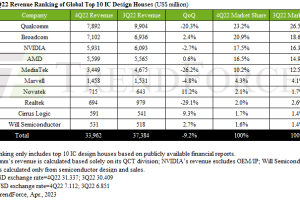
Although 2022 won’t be a disaster, 2023 will be, said Penn.
This year the growth forecast is +6%. +10% is still possible, but so is +4%.
“The slowdown is inevitable, the magnitude of it depends on the timing,” said Penn, “unit shipments will plummet first then ASPs will collapse”
Next year the market goes negative, forecast Penn.
“The industry’s 17th downcycle fuse is already burning because of a collapsing chip market combined with a global economic downturn,” said Penn.
In 2023, Q1 will be down -10%; Q2 will be down -8%; Q3 will be down -4%; Q4 will be down -2.5%. The full year will be down -22%.
The cycles are endemic because of a lack of collaboration between the suppliers and the users.
”Customers always get their forecasts wrong – they’re worse than the semiconductor industry,” said Penn.
Flaky forecasting on both sides of the industry results in a constant imbalance between demand and supply.
“The industry’s cycles are driven by supply and demand imbalance rather than the market,” said Penn, “and the only way to match them up is for the supplier and the customer to have a shared responsibility for building future capacity. No one wants that.”
Systems companies should be prepared to pay more for capacity because, whereas semiconductor companies get $9 per sq cm of silicon, systems houses get $45 per sq cm.
Despite that “there’s no one prepared to pony up and put money in the chip industry,” said Penn.
Apple is the only systems company prepared to invest in fab capacity through its understanding with TSMC, said Penn, and even that relationship has its limits.
So there’s nothing to change the traditional volatile cycle.
 Electronics Weekly Electronics Design & Components Tech News
Electronics Weekly Electronics Design & Components Tech News



